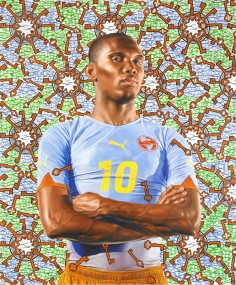
Exhibit plays on obsession with the world's game


Running at the Los Angeles County Museum of Art (Lacma) until July 20 - a week after the World Cup ends in Brazil - the exhibition features about 50 works by 30 artists in a variety of media: sculptures, installations, videos, photographs and paintings
On a purely visual level, there is enough to enchant, starting with the sculpture that greets visitors. Maracaña by Nelson Leirner, is on loan from the Brooklyn Museum. The plaster, plastic, ceramic and wood piece is three metres long and is based on the stadium of the same name in Brazil. But Leirner took a tongue-in-cheek approach, filling his "pitch" with footballers in the shape of The Hulk or Power Rangers, and the stadium seating with cheap ceramic cats, dozens of Jesus statuettes with their arms outstretched, Buddha figurines, kittens and frogs.
From Andreas Gursky comes a chromogenic print, an aerial shot of a symmetry of players taken at the EM Arena in Amsterdam in 2000; from Andy Warhol, his silkscreen of soccer great Pelé, done in 1978, with the smiling sportsman holding a ball to his head.
Even for those who couldn't care less about soccer, the exhibit offers an insight into the minds of a number of artists of varying pedigrees, conveying how soccer is perceived on different levels. Michael Govan, chief executive and director of the Wallis Annenberg section of Lacma, describes the exhibition as "a globally beloved sport celebrated in the context of a museum".
"What a great opportunity to explore the international scope of soccer through the lens of art," he says.
There are abstract pieces, as well, showcasing the almost mythical qualities ascribed to the sport. George Afedzi Hughes' Masked Goalkeeper is an oil on canvas that shows body-less lungs, an amputated leg, its foot wearing soccer boots, and a skeletal hand clutching a red soccer ball - an inverted dollar sign anchoring the centre of the piece. The somewhat disturbing assemblage of parts is left up to the interpretation of the viewer.
Other exhibits are fun and quirky, like Leo Fitzmaurice's piece entitled Post Match, a grouping of crumpled cigarette packets folded into miniature soccer team shirts, the lot framed behind glass. Mark Bradford's Soccer Ball Bag is just that - a standard net bag into which several balls are stuffed, this one suspended from the ceiling and holding papier-mâché balls.
The expansive show, which takes over several rooms at the museum, is a boon for true fans, who would be quite happy to set aside 90 minutes to watch a video installation of a "match" between Mexico and Brazil submitted by Mexican artist Miguel Calderón. It shows action from numerous matches seamlessly edited together but with the highly improbable final score of Mexico 17: Brazil 0.
Or, for followers of Zinedine Zidane, widely considered one of the greatest soccer players in history, there is Philippe Parreno and Douglas Gordon's Zidane: A 21st Century Portrait, which is a video of close-ups of the French-Algerian's moves and responses during a single match.
What is especially intriguing at the exhibition is to note how different artists view this most beloved of sports, even in the US, where soccer doesn't enjoy the same popularity as American football or basketball.
Franklin Sirmans, a curator of contemporary art, says it's the obsession with the sport itself that has fuelled the imagination of so many artists over the years.
"It's the blanket fact that soccer is the most obsessed-about sport in the world, and so artists, being a subpopulation, will be somewhat proportional in their interest," he says. "It's interesting to engage with international artists and see a thread of similarity in their consideration of the sport."